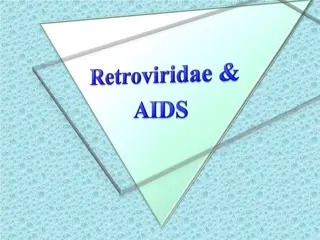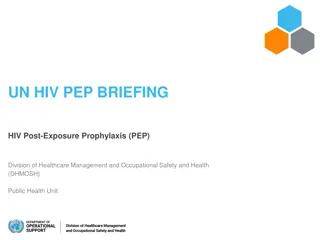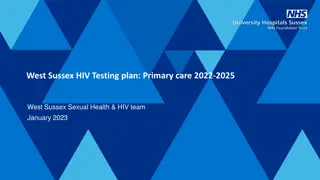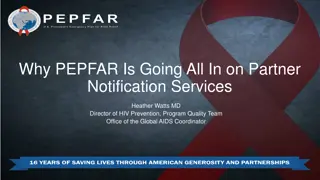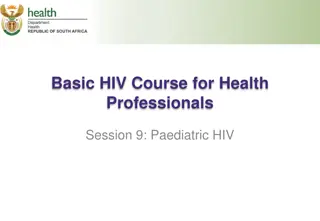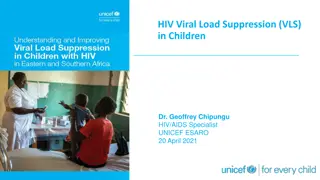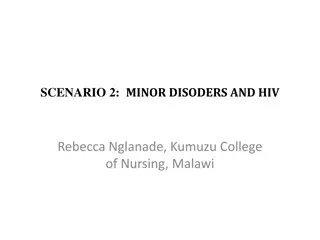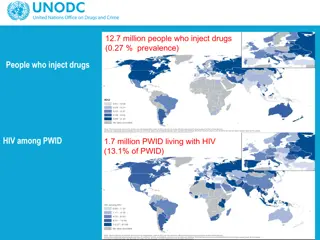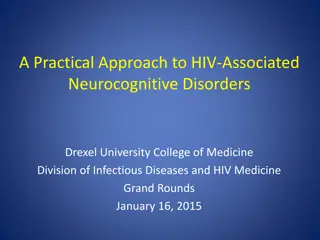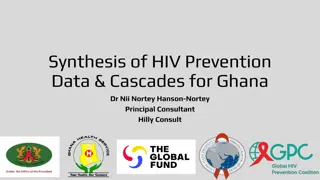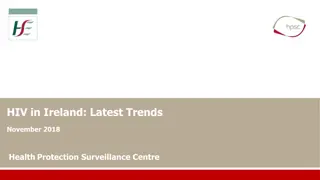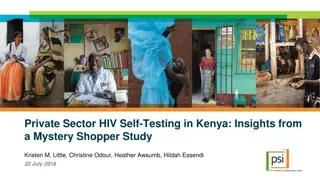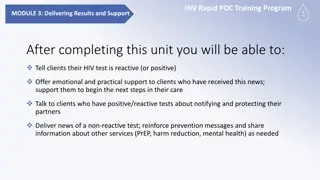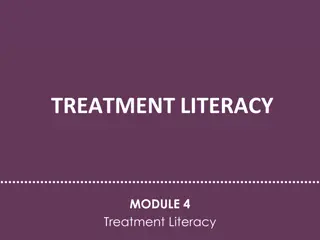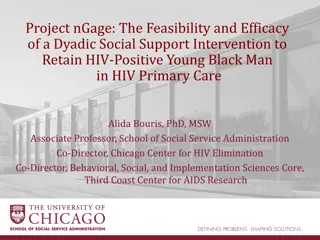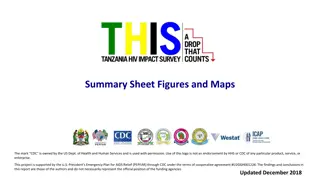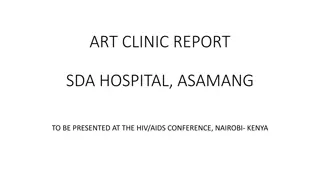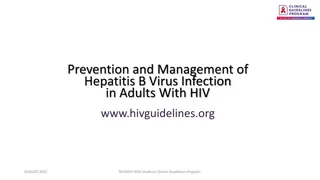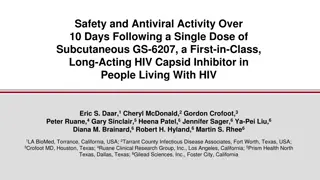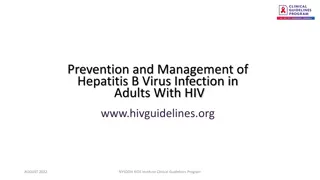Diagnosis and Management of Acute HIV Infection
Guideline aims to recognize the risks, signs, and symptoms of acute HIV infection and to promote HIV testing in individuals presenting with flu-like symptoms or viral syndromes. It provides recommendations for diagnostic testing, treatment, and prevention services to improve patient health and reduc
1 views • 19 slides
Update on HIV and AIDS Prevention Guidelines 2022
This update highlights key points from the PMK No. 23/2022 on combating HIV, AIDS, and STIs. It covers terminologies, goals for eliminating HIV and AIDS by 2030, and strategies such as PrEP and PEP. The guidelines emphasize timely interventions like Post-Exposure Prophylaxis (PEP) and Pre-Exposure P
3 views • 38 slides
The Differences Between HIV and AIDS, Importance of Prevention
HIV and AIDS are closely related, with HIV being the virus that leads to AIDS. HIV weakens the immune system by attacking specific white blood cells, while AIDS is the advanced stage of HIV infection. Prevention is crucial as AIDS is a deadly, incurable disease. The transmission of HIV primarily occ
4 views • 14 slides
Human Immunodeficiency Virus
HIV, a member of the lentivirus subfamily of retroviruses, causes Acquired Immunodeficiency Syndrome (AIDS). HIV-1 and HIV-2 have distinct characteristics, with HIV-1 being global and HIV-2 primarily in West Africa. The virus encodes reverse transcriptase and has an envelope containing glycoproteins
1 views • 31 slides
HIV Post-Exposure Prophylaxis (PEP) and Prevention
HIV Post-Exposure Prophylaxis (PEP) is a crucial emergency medical response for individuals exposed to HIV, aiming to prevent infection. It involves a regimen of medications, tests, and counseling services initiated within 72 hours of exposure. HIV transmission occurs through body fluids like blood,
4 views • 27 slides
TB and HIV Overview for World TB Day March 2022
This content provides an overview of the relationship between TB and HIV, emphasizing the importance of testing HIV patients for latent TB infection and TB patients for HIV. It also outlines the guidelines for managing these co-infections, including diagnostic tests, treatment strategies, and patien
0 views • 17 slides
West Sussex HIV Testing Plan: Strategies for Improved Diagnosis and Treatment
West Sussex's HIV testing plan for 2022-2025 focuses on reducing domestic transmissions by implementing targeted strategies in primary and secondary care settings. While overall prevalence is low, certain areas in West Sussex exhibit higher rates, necessitating tailored testing approaches. The plan
0 views • 6 slides
PEPFAR's Focus on Partner Notification Services for HIV Prevention
PEPFAR is intensifying efforts on partner notification services for HIV prevention to address the global issue of undiagnosed HIV cases. The initiative aims to improve testing strategies, increase testing volumes, and enhance epidemic control. By reaching HIV testing targets and implementing efficie
0 views • 24 slides
Paediatric HIV Testing and Treatment Guidelines
Understanding the importance of early diagnosis in HIV-infected infants and children is crucial for timely intervention and improved health outcomes. This session covers testing algorithms, initiation of antiretroviral therapy, viral load monitoring, and legal issues related to HIV testing in childr
2 views • 31 slides
Addressing Viral Load Suppression in Children with HIV: Insights and Recommendations
This study led by Dr. Geoffrey Chipungu, an HIV/AIDS Specialist at UNICEF ESARO, explores the rates, trends, and factors associated with HIV viral load suppression (VLS) in children. The research reveals sub-optimal VLS rates in children compared to adults, highlighting the need for improved policie
5 views • 12 slides
HIV: Basics, Stages, and Treatment
HIV, Human Immunodeficiency Virus, attacks the immune system and can progress to AIDS if left untreated. Antiretroviral Therapy (ART) helps control HIV, allowing individuals to live healthy lives. The stages of HIV include Acute Infection, Chronic Infection, and the most severe stage, AIDS. Early de
0 views • 29 slides
HIV Rapid Test Procedures and Instructions
This content provides detailed instructions for conducting HIV rapid tests using three different kits: Determine HIV-1/2 Rapid Test, Uni-Gold HIV-1/2 Rapid Test, and Bioline HIV-1/2 Rapid Test. The instructions include steps such as specimen collection, test device preparation, result interpretation
0 views • 5 slides
Overview of Ryan White CARE Act: 30 Years of Lifesaving Care for People Living with HIV/AIDS
August 18, 2020, marked the 30th anniversary of the Ryan White CARE Act, a landmark legislation that established the Ryan White HIV/AIDS Program providing care and treatment services to individuals with HIV in the U.S. The Act has been amended several times to extend and revise its purpose, no longe
0 views • 21 slides
The Impact of HIV on Nutrition
This training session focuses on the relationship between undernutrition and HIV, discussing how HIV/AIDS affects nutrition among People Living with HIV (PLHIV). It covers the benefits of good nutrition for PLHIV and provides recommendations for Nutrition Assessment, Counselling, and Support (NACS)
1 views • 27 slides
Cutaneous Manifestations of HIV and AIDS
Human Immunodeficiency Virus (HIV) is a lentivirus that infects CD4 T lymphocytes, leading to Acquired Immunodeficiency Syndrome (AIDS). Cutaneous manifestations of HIV/AIDS vary depending on the stage of infection and CD4 T cell counts. Early signs include exanthem, oral hairy leukoplakia, candidia
0 views • 17 slides
Exploring the Use of PrEP to Reduce HIV Transmission Among African American Men
In response to the HIV/AIDS pandemic, this study focuses on the effectiveness of Pre-Exposure Prophylaxis (PrEP) in reducing HIV transmission among African American men who have sex with men in Orangeburg, SC. The research aims to investigate the impact of PrEP compared to condom use, and the necess
0 views • 6 slides
Challenges Faced by Pregnant Women with HIV Diagnosis in Malawi
Maria, a pregnant woman in Malawi, faces the challenge of an unexpected pregnancy and a positive HIV diagnosis. The scenario explores her concerns, midwifery diagnosis, preparation for HIV testing, disclosure of results, and maintaining confidentiality in antenatal care. It also delves into factors
1 views • 10 slides
Global Impact of HIV Among People Who Inject Drugs
12.7 million people worldwide inject drugs, with 1.7 million of them living with HIV. The prevalence of HIV among people who inject drugs is 13.1%, highlighting the need for comprehensive service provision including testing, needle programs, opioid therapy, and antiretroviral treatment. The data als
0 views • 4 slides
Role of REG3 and I-FABP in HIV-Related Gut Permeability and Inflammation
This presentation highlights the significance of Regenerating Islet-Derived Protein-3 (REG3) and Intestinal Fatty Acid Binding Protein (I-FABP) in microbial translocation, inflammation, and reservoir size in individuals living with HIV. REG3 and I-FABP serve as markers of gut epithelial damage and p
0 views • 7 slides
Impact of Global Declines in HIV Testing and Service Disruptions on Future Healthcare
Global declines in HIV testing and reductions in new initiators, coupled with disruptions in HIV services due to COVID-19, pose challenges for future healthcare. Short-term disturbances could lead to increased HIV-related mortality, emphasizing the need for program responses to mitigate adverse effe
0 views • 10 slides
HIV-Associated Neurocognitive Disorders: A Practical Approach
HIV/AIDS presents complex medical and psychiatric challenges, including HIV-Associated Neurocognitive Disorders (HANDs), which impact patients, families, and caregivers. This presentation by Dr. Mary Ann Adler Cohen provides insights into the prevalence, impact, diagnosis, and treatment of HANDs, em
0 views • 56 slides
Resistance Analysis of Long-Acting Lenacapavir in HIV Treatment: 104-Week Findings
Study on long-acting lenacapavir in heavily treatment-experienced HIV individuals after 104 weeks revealed emergence of lenacapavir resistance-associated mutations. Lenacapavir, a potent HIV-1 capsid inhibitor, has shown activity against ARV-resistant strains. The CAPELLA study analyzed lenacapavir
0 views • 11 slides
Comprehensive Overview of HIV Prevention Strategies and Interventions
This synthesis covers the importance of monitoring progress in HIV prevention through data cascades, the need for standardized frameworks, promoting effective HIV prevention programs in diverse social contexts, and the key pillars of combination HIV prevention strategies. It also outlines various HI
0 views • 40 slides
HIV Diagnosis Trends in Ireland (November 2018)
The HIV diagnosis rate in Ireland has shown stability with some fluctuations between 2015 and 2017. There were increases and decreases in diagnosis rates among males and females, with notable trends in different age groups. Diagnoses among men who have sex with men slightly decreased, while there wa
0 views • 21 slides
Basic HIV Course for Health Professionals Session 1: Introduction to HIV
This session introduces basic epidemiological concepts, differentiates between HIV and AIDS, explains the HIV life cycle, and discusses how HIV is transmitted. Definitions of key terms like prevalence, incidence, mortality rate, and morbidity are provided. The session also highlights the differences
0 views • 30 slides
Insights into Private Sector HIV Self-Testing in Kenya
A mystery shopper study was conducted to assess the private sector's effectiveness in providing high-quality HIV self-testing services to adolescents and young people in Kenya. The study focused on pharmacies and private health facilities participating in an HIV self-testing demonstration project. M
0 views • 25 slides
HIV Rapid POC Training Program - Delivering Results and Support
In Module 3 of the HIV Rapid POC Training Program, you will learn how to handle delivering reactive (or positive) HIV test results to clients. It covers providing emotional support, discussing next steps in care, notifying and protecting partners, and reinforcing prevention messages. The module emph
1 views • 13 slides
Role of V3 Region in HIV Entry to CD4 T-Cells
The V3 region of gp120 plays a crucial role in HIV entry to CD4 T-cells by determining the coreceptor usage. Studies focus on the structural aspects of V3, its conservation, coreceptor binding, and antibody accessibility. The HIV envelope structure, including trimeric spikes with gp120 and gp41 glyc
0 views • 24 slides
Assessment of HIV Prevention Programme Needs and Barriers in Ghana
Conduct a data-driven assessment of HIV prevention programme needs and barriers in Ghana based on the Ghana Road Map Baseline Survey components. Evaluate the country's preparedness in addressing HIV epidemic patterns and prevention response analysis. Identify key barriers hindering HIV prevention ef
0 views • 11 slides
HIV and AIDS: The Progression in Adult Natural History
HIV infection progresses in stages from acute infection with flu-like symptoms to a latency period of no symptoms, then advancing to AIDS where the immune system is significantly weakened, leading to opportunistic infections and HIV-related cancers. The virus targets CD4 cells, impacting the immune
0 views • 29 slides
Project nGage: Dyadic Social Support Intervention for HIV-Positive Young Black Men
Research led by Alida Bouris focuses on the feasibility and efficacy of a dyadic social support intervention to retain HIV-positive young Black men in HIV primary care. Supported by the National Institute of Mental Health, the project aims to enhance engagement in care and improve health outcomes th
0 views • 45 slides
Therapeutic Trials in HIV/HCV Coinfection: ION-4, Ally-2, and Viroteam 2015
In the study of therapeutic trials in HIV/HCV coinfection between 2014-2015, notable trials included ION-4 with LDV/SOF treatment for 12 weeks in HCV/HIV co-infection patients, showing high SVR rates in both treatment-naive and experienced patients. Another trial, Ally-2, involved Daclatasvir and So
2 views • 15 slides
Prospective Cohort Study on Acute HIV Infection in Bangkok
The study focuses on initiating combination antiretroviral therapy for all HIV-infected individuals to preserve the CD4+ T cell population, restrict viral reservoir seeding, and minimize viral evolution. Rapid suppression of HIV viraemia in patients could lead to potential candidates for future cure
0 views • 12 slides
HIV Project Summary Sheet and Figures
HIV Project Summary Sheet and Figures include data on HIV prevalence by age and sex, viral load suppression among people living with HIV, achievement of the 90-90-90 goals, and more. The project is supported by the U.S. President's Emergency Plan for AIDS Relief (PEPFAR) through the CDC. Findings an
0 views • 7 slides
Challenges in the Management and Treatment of HIV/Hepatitis C Virus Coinfection
This presentation by Dr. Ricardo A. Franco focuses on the challenges faced in managing and treating patients with HIV/Hepatitis C virus coinfection. It discusses the burden of HCV mono-infection and HIV/HCV co-infection, the impact of HIV co-infection on survival in HCV-related cirrhosis, and the ro
6 views • 26 slides
Breaking Barriers: Understanding U=U in HIV Prevention
The concept of Undetectable=Untransmittable (U=U) has reshaped how we approach HIV prevention, with evidence emphasizing viral load as a key factor in transmission risk. Landmark studies like the Partner Study and HPTN 052 have solidified the U=U message, showcasing significant reductions in HIV tra
0 views • 28 slides
HIV/AIDS Clinic Report at SDA Hospital, Asamang - Presented at Conference
The ART Clinic at SDA Hospital in Asamang, Kenya, is dedicated to providing care and treatment for HIV/AIDS patients. With a focus on HIV testing, counseling, psychological support, and providing ART drugs, the clinic aims to achieve the 90-90-90 target by 2030. Through key activities like the Know
1 views • 20 slides
Hepatitis B Virus Management in Adults with HIV
This guideline focuses on increasing awareness among clinicians regarding the prevalence and risks of chronic HBV in HIV patients. It emphasizes the importance of screening, vaccination, diagnosis, treatment, and monitoring of chronic HBV infection in adults with HIV. The document also outlines New
0 views • 27 slides
Safety and Antiviral Activity of GS-6207: A First-in-Class HIV Capsid Inhibitor
GS-6207 is a novel long-acting HIV capsid inhibitor with promising antiviral activity and safety profile in people living with HIV. The study evaluates the efficacy of a single subcutaneous dose of GS-6207 in reducing plasma HIV-1 RNA levels over 10 days. Results show potential benefits for heavily
0 views • 13 slides
Guidelines for Preventing and Managing Hepatitis B in HIV-Positive Adults
This guideline aims to increase awareness among clinicians regarding the prevalence and risks of chronic HBV in HIV-infected patients. It emphasizes screening, vaccination, and evidence-based recommendations for diagnosis, treatment, and monitoring of chronic HBV in individuals with HIV. Key recomme
2 views • 24 slides



